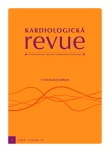-
Medical journals
- Contact
Antithrombotics in the prevention of cerebrovascular accidents. Part II – Significance of anticoagulant therapy
Authors: Prof. MUDr. Jan Bultas, CSc.; doc. MUDr. Debora Karetová, CSc.
Authors‘ workplace: II. interní klinika kardiologie a angiologie 1. LF UK a VFN, Praha ; Jan. Bultas@lf3. cuni. cz ; Farmakologický ústav 3. LF UK, Praha
Published in: Kardiol Rev Int Med 2013, 15(1): 41-53
Category:
Overview
Cerebrovascular accidents of ischemic etiology most frequently occur in the background of atherothrombosis, in which case antiplatelet treatment plays a crucial role in the prophylaxis, or they are of thromboembolic origin, usually related to cardioembolization, in which case prevention is based on anticoagulant treatment. The strategy of blockage of primary haemostasis was the subject of the first part of the overview while this part focuses on the inhibition of secondary haemostasis, i.e. on anticoagulants. Currently, we have anti-vitamins K available in the indication of prophylaxis of thromboembolic incidents in patients with atrial fibrillation, specifically warfarin, which inhibits more coagulation factors, or direct inhibitors of thrombin (dabigatran) or factor Xa (rivaroxaban and, awaiting approval for clinical use, apixaban). Considering the great inter - and intra-individual variability of the effect of warfarin in the background of interactions with drugs and food as well as of pharmacogenetic influences, the slow onset of action and several other unfavourable pharmacological properties, the above-mentioned direct inhibitors of thrombin or factor Xa were introduced. Direct comparison with warfarin has demonstrated the greater efficacy and safety of the newly introduced anticoagulants.
Keywords:
cerebrovascular accident – atrial fibrillation – warfarin – dabigatran – rivaroxaban – apixaban
Sources
1. Patel MR, Mahaffey KW, Garg J et al. Rivaroxaban versus warfarin in nonvalvular atrial fibrillation. N Engl J Med 2011; 365 : 1557–1559.
2. ROCKET AF Study Investigators. Rivaroxaban-oncedaily, oral, direct factor Xa inhibition compared with vitamin K antagonism for prevention of stroke and Embolism Trial in Atrial Fibrillation: rationale and design ofthe ROCKET AF study. Am Heart J 2010; 159 : 340–347.
3. Hart RG, Pearce LA, Aguilar MI. Meta-analysis: antithrombotic therapy to prevent stroke in patients who have nonvalvular atrial fibrillation. Ann Intern Med 2007; 146 : 857–867.
4. Marlu R, Hodaj E, Paris A et al. Effectof non-specific reversal agents on anticoagulant activity of dabigatran and rivaroxaban. A randomised crossover ex vivo study in healthy volunteers. Thromb Haemost 2012; 108 : 217–224.
5. Connolly SJ, Ezekowitz MD, Yusuf S et al. RE-LY Steering Committee and Investigators. Dabigatran versus warfarin in patients with atrial fibrillation. N Engl J Med 2009; 361 : 1139–1151.
6. European Medicines Agency updates patient and prescriber information for Pradaxa. Press release 25/05/2012. http://www.ema.europa.eu/docs/en_GB/document_library/Press_release/2012/05/WC500127771.pdf.
7. Granger CB, Alexander JH, McMurray JJ et al. ARISTOTLE Committees and Investigators. Apixaban versus warfarin in patients with atrial fibrillation. N Engl J Med 2011; 365 : 981–992.
8. http://www.thepharmacyconnection.com. Dabigatran versus rivaroxaban for the prevention of stroke and system icembolism in atrial fibrillation. http://www.thepharmacyconnection.com/cardiology/2012/08/19/dabigatran-rivaroxaban-prevention-stroke-systemic-embolism-atrial-fibrillation/#lyrPqAwz0LkAwILc.99.
9. Connolly SJ, Eikelboom J, Joyner C et al. AVERROES Steering Committee and Investigators. Apixaban in patients with atrial fibrillation. N Engl J Med 2011; 364 : 806–817.
10. Furie KL, Goldstein LB, Albers GW et al. Oral Antithrombotic Agents for the Prevention of Stroke in Nonvalvular Atrial Fibrillation: A Science Advisory for Health care Professionals From the American Heart Association/American Stroke Association. Stroke 2012 Aug 2. [Epub ahead of print].
11. Camm AJ, Lip GYH, De Caterina R et al. 2012 focused update ofthe ESC Guidelines for the management of atrial fibrillation. Eur Heart J 2012; 33 : 2719–2747. http://www.escardio.org/guidelines-surveys/esc-guidelines/GuidelinesDocuments/Guide-lines_Focused_Update_Atrial_Fib_FT.pdf.
12. Fuster V, Rydén LE, Asinger RW et al. ACC//AHA/ESC guidelines for the management of patients with atrial fibrillation: executive summary. A Report of the American College of Cardiology/American Heart Association Task Force on Practice Guidelines and the European Society of Cardiology Committee for Practice Guidelines and Policy Conferences (Committee to Develop Guidelines for the Management of Patients With Atrial Fibrillation): developed in Collaboration With the North American Society of Pacing and Electrophysiology. J Am Coll Cardiol 2001; 38 : 1231–1266.
13. Chris Granger, Symposium ESC congress Paris, 2011 (von Granger, Duke, ESC 2011).
Labels
Paediatric cardiology Internal medicine Cardiac surgery Cardiology
Article was published inCardiology Review

2013 Issue 1-
All articles in this issue
- Arrhythmias and stroke
- Prevention of ischemic stroke
- Antithrombotics in the prevention of cerebrovascular accidents. Part II – Significance of anticoagulant therapy
- Blood pressure control in primary and secondary prevention of stroke
- Levosimendan in cardiac surgery
- The most important diagnostic procedures in acute stroke
- Therapy of acute ischemic stroke
- Cardiology Review
- Journal archive
- Current issue
- Online only
- About the journal
Most read in this issue- The most important diagnostic procedures in acute stroke
- Therapy of acute ischemic stroke
- Prevention of ischemic stroke
- Arrhythmias and stroke
Login#ADS_BOTTOM_SCRIPTS#Forgotten passwordEnter the email address that you registered with. We will send you instructions on how to set a new password.
- Contact

